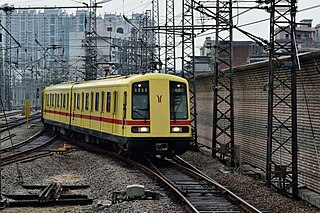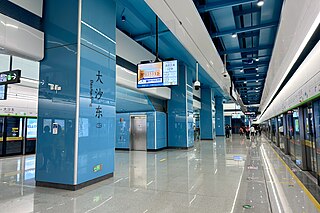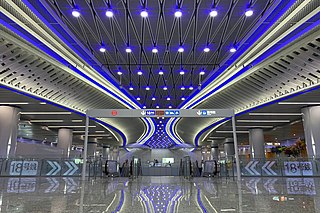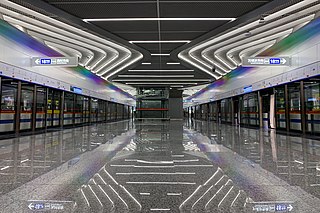
Nan'an is a county-level city of southern Fujian Province, People's Republic of China. It is under the administration of Quanzhou City and as of 2023, had a total population of 1,663,542. More than 4,000,000 overseas Chinese trace their ancestry to Nan'an.

The Guangfo Metro or Guangfo line is a intercity metro line that connects the Chinese cities of Foshan and Guangzhou. As of December 2018, the line is currently 39.6 km (24.61 mi) long and has 25 stations, which are all underground.

Line 1 of the Guangzhou Metro runs from Xilang to Guangzhou East Railway Station. Apart from Kengkou and Xilang, all stations in Line 1 are underground. The first section, from Xilang to Huangsha, opened on 28 June 1997, making Guangzhou the fourth city in mainland China to have a metro system. Construction took a total of 66 months. The total investment is 12.2616 billion yuan with an average cost per kilometer of 662.9 million yuan. The full line started operation on 28 June 1999. Line 1 is coloured yellow.

Line 3 of the Guangzhou Metro is a 65.43-kilometer (40.66 mi) rapid transit line connects Panyu Square to Tianhe Coach Terminal. The entire line, including all track and stations, is located in tunnels. Its 57.93 km (36.00 mi) main branch, excluding the 7.5 km (4.66 mi) branch between Tianhe Coach Terminal and Tiyu Xilu, is now the third longest continuous subway tunnel in the world, and the longest rail tunnel of any kind.

Tanwei Station, formerly Datansha South Station and Datansha Station during planning, is an elevated station on Line 5 of the Guangzhou Metro and an underground station on Line 6. It is located at Zhongshuangqiao Park (中双桥公园) on Datansha Island in the Liwan District. It opened on 28 December 2009. It became an interchange station between Line 5 and Line 6 on 28 December 2013.

Dashadong Station, formerly Dashadi Station (大沙地站) during planning, is an interchange station between Line 5 and Line 7 of the Guangzhou Metro. It is located underground the junction of East Dashadi Road (大沙地东路) and Zhendong Road (镇东路), in the Huangpu District. Line 5 opened on 28 December 2009, whilst Line 7 opened on 28 December 2023.
Haixinsha Island is an island in Haizhu District, Guangzhou, Guangdong, China. It is located between Luoxi Bridge and Xinguang Bridge. It is at the south of Lijiao Station of Haizhu Island and the north of Luoxi Island of Panyu District.

Line 5 of the Guangzhou Metro runs from Liwan District to Huangpu District. It starts at Jiaokou running 41.7 km (25.91 mi) in a wide "∩" shape and ends at Huangpu New Port. Like lines 4 and 6, it is equipped with linear induction motor technology. Line 5's color is red. Line 5 began operation on 28 December 2009, from Jiaokou to Wenchong. On December 31, 2009, Line 5 set a record of 567,000 daily passengers, surpassing the ten year ridership projections in the span of just 4 days after its opening. As of May 2017, Line 5 carries an average of 1.05 million passengers per day and is extremely congested throughout the day, operating at over 100% capacity during rush hours. The opening of Phase I of Line 13 further increased traffic demand on the west end of Line 5 and pushing congestion to over 130% capacity. Prompting the Guangzhou Metro to limit passenger traffic at a number of subway stations on Line 5. In 2018, the busiest section of Line 5 reaches over 50,000 pphpd of traffic volume during peak periods. By 2019, the line was used by 1.18 million passengers each day. In the future Line 13 Phase II will provide relief for Line 5. On 28 December 2023, the line was extended to the east from Wenchong to Huangpu New Port.

The Ningbo−Zhoushan Expressway, commonly referred to as the Yongzhou Expressway, is an expressway in Zhejiang, China which links Ningbo to Zhoushan. In the National Trunk Highway System (NTHS) in China, the number of this highway is G9211.

The Luoyang Bridge, also known as Wan'an Bridge, is located in Quanzhou, Fujian province, China. The stone bay bridge is situated at the mouth of Luoyang River. Being the first stone bay bridge in China, it enjoys the reputation of "one of the four ancient bridges of China".

Line 18 of the Guangzhou Metro is a rapid transit express line in Guangzhou with trains operating up to 160 km/h (99 mph). It will run in a south-north direction, connecting Wanqingsha in Nansha District, Panyu Square in Panyu District, Modiesha in Haizhu District, Zhujiang New Town and Guangzhou East Railway Station in Tianhe District. The line commenced service on 28 September 2021.

Line 22 of the Guangzhou Metro is a partially open rapid transit express line in Guangzhou with trains operating up to 160 km/h (99 mph). It runs between Panyu Square and Chentougang, passing Guangzhou South Railway Station in Panyu District, and will eventually run in a north-south direction passing Xilang and Fangcun in Liwan District. Currently, there are train attendants on board each train. In the future, trains will operate fully driverless GoA4 mode when sufficient reliability from the signaling system has been confirmed.
Xinjia Express Hotel was a hotel in Licheng District, Quanzhou, Fujian, China. On 7 March 2020, while being used to quarantine COVID-19 patients, it collapsed from overloading resulting from illegal construction, killing 29 people and injuring another 42.
Line 12 of the Guangzhou Metro is a fully automated rapid transit line under construction in Guangzhou, China. It was originally planned to open for operation in 2023, but due to the obstruction of the construction progress, it was announced in 2022 that it was expected to be completed in 2024.

Shuixi station, is an interchange station between Line 7 and Line 21 of the Guangzhou Metro. Line 21 opened on 20 December 2019., whilst Line 7 opened on 28 December 2023.

Hongshengsha Station is a station of Guangzhou Metro Line 7, located underground on the west side of Hongshengsha Island in Guangzhou's Huangpu District. The civil works and mechanical and electrical works of the station have been basically completed, but because Hongshengsha Island, where the station is located, has not been developed, and the construction of various municipal supporting facilities has not been completed, the station does not have the opening conditions, so the station cannot be opened simultaneously with the second phase of Line 7, and trains currently pass the station without stopping. It will not open until the island is more developed.

Shaxi Station is a station on Line 18 of the Guangzhou Metro, located underground northwest of the intersection of Panyu Bridge and Shaxi Avenue on Shajiao Island in Guangzhou's Panyu District. It opened on 28 September 2021.

Hengli Station is a station on Line 18 of the Guangzhou Metro, located underground at the west side of Fenghuang Dadao on Hengli Island in Guangzhou's Nansha District. It opened on 28 September 2021.
Lixinsha Bridge, also known as Lixindao Bridge, Sanmin Island Bridge, or Hongqili Second Bridge. Located in Guangzhou, Guangdong, China, the bridge connects Sanmin Island, one of the smaller islands along the Hongqili Waterway to the Jiuyong and the rest of the urban area. As the only land bridge connecting Sanmin Island, it carries the island's only water supply pipeline.
















